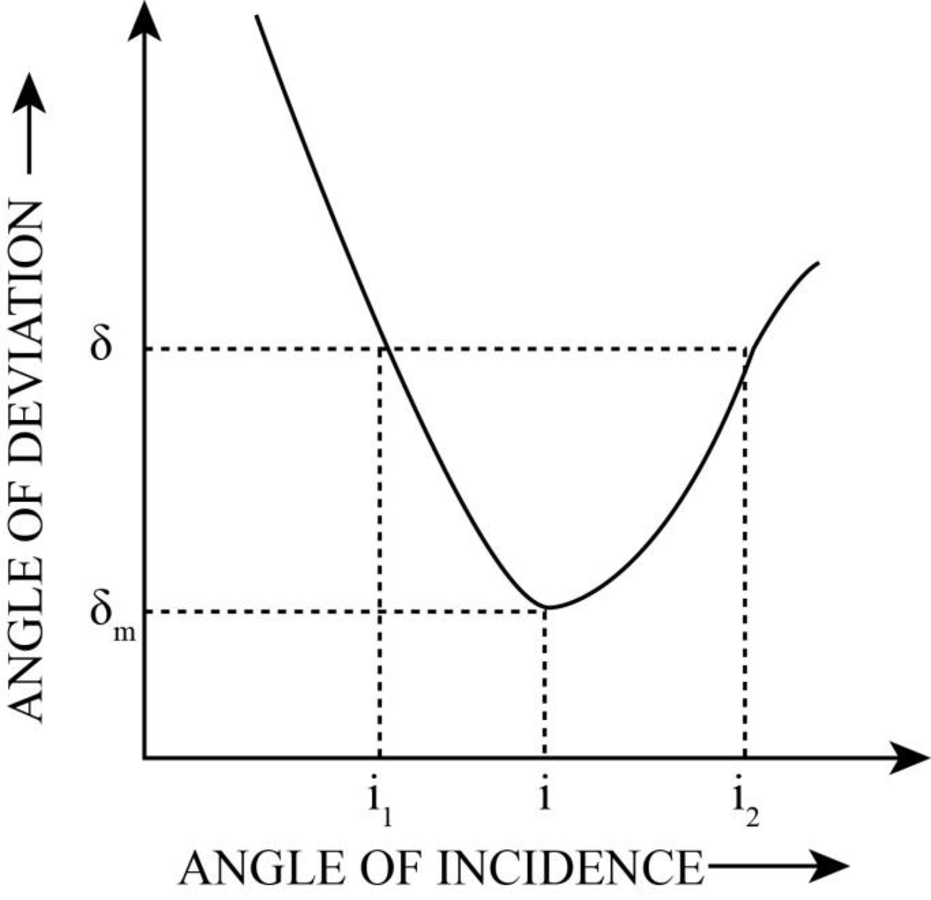
Concept explainers
(a)
The proof that total deviation of a ray from its original path is
(a)
Answer to Problem 124PQ
The total deviation of a ray from its original path is
Explanation of Solution
Write the expression for refraction law at left side of the given prism.
Here,
Write the expression for refraction law at right side of the given prism.
Here,
Write the expression angle of deviation of the given prism.
Here,
Write the relation among various angle from the geometry of the prism.
Substitute
Further solve this for
Use general trigonometric relation for conversion.
Substitute
Substitute
Substitute
Conclusion:
Therefore, it is proved that the angle of deviation is
(b)
The plot of the angle of deviation versus the angle of incidence for
(b)
Answer to Problem 124PQ
The graph is following.

Explanation of Solution
Write the expression for the angle of deviation of the given prism.
Conclusion:
Substitute
Deviation varies linearly, decreases and then increases approximately with incidence angle
Therefore, the plot of the angle of deviation versus the angle of incidence is as follows.

Figure-(1)
(c)
The incidence angle for which the derivation angle is minimum.
(c)
Answer to Problem 124PQ
The incidence angle for which deviation is minimum is
Explanation of Solution
The minimum deviation occurs when the incident and the refracted ray are identical and make equal angles to the normal of the prism.
The angle exhibits a minimum at
Conclusion:
The minimum angle of deviation depends on the refractive index for different wavelength, the refractive index is different.
Want to see more full solutions like this?
Chapter 38 Solutions
Physics for Scientists and Engineers: Foundations and Connections
- Light is incident on a prism as shown in Figure P38.31. The prism, an equilateral triangle, is made of plastic with an index of refraction of 1.46 for red light and 1.49 for blue light. Assume the apex angle of the prism is 60.00. a. Sketch the approximate paths of the rays for red and blue light as they travel through and then exit the prism. b. Determine the measure of dispersion, the angle between the red and blue rays that exit the prism. Figure P38.31arrow_forwardHow many times will the incident beam in Figure P34.33 (page 922) be reflected by each of the parallel mirrors? Figure P34.33arrow_forwardAn object is placed a distance of 10.0 cm to the left of a thin converging lens of focal length f = 8.00 cm, and a concave spherical mirror with radius of curvature +18.0 cm is placed a distance of 45.0 cm to the right of the lens (Fig. P38.129). a. What is the location of the final image formed by the lensmirror combination as seen by an observer positioned to the left of the object? b. What is the magnification of the final image as seen by an observer positioned to the left of the object? c. Is the final image formed by the lensmirror combination upright or inverted? FIGURE P38.129arrow_forward
- Figure P23.28 shows a curved surface separating a material with index of refraction n1 from a material with index n2. The surface forms an image I of object O. The ray shown in red passes through the surface along a radial line. Its angles of incidence and refraction are both zero, so its direction does not change at the surface. For the ray shown in blue, the direction changes according to n1 sin 1 = n2 sin 2. For paraxial rays, we assume 1 and 2 are small, so we may write n1 tan 1 n2 tan 2. The magnification is defined as M = h/h. Prove that the magnification is given by M = n1q/n2p. Figure P23.28arrow_forwardTwo converging lenses having focal lengths of f1 = 10.0 cm and f2 = 20.0 cm are placed a distance d = 50.0 cm apart as shown in Figure P35.48. The image due to light passing through both lenses is to be located between the lenses at the position x = 31.0 cm indicated. (a) At what value of p should the object be positioned to the left of the first lens? (b) What is the magnification of the final image? (c) Is the final image upright or inverted? (d) Is the final image real or virtual?arrow_forwardFigure P23.28 shows a curved surface separating a material with index of refraction n1 from a material with index n2 . The surface forms an image I of object o. The ray shown in red passes through the surface along a radial line. Its angles of incidence and refraction are both zero, so its direction does not change at the surface. For the ray shown in blue, the direction changes according to n1 sin θ1 = n2 sin02 . For paraxial rays, we assume θ1 and θ2 are small, so we may write n1 tan θ1 = n2 tan θ2. The magnification is defined as M =h′/h. Prove that the magnification is given by M = −n1 q/n2p.arrow_forward
 College PhysicsPhysicsISBN:9781305952300Author:Raymond A. Serway, Chris VuillePublisher:Cengage Learning
College PhysicsPhysicsISBN:9781305952300Author:Raymond A. Serway, Chris VuillePublisher:Cengage Learning Physics for Scientists and EngineersPhysicsISBN:9781337553278Author:Raymond A. Serway, John W. JewettPublisher:Cengage Learning
Physics for Scientists and EngineersPhysicsISBN:9781337553278Author:Raymond A. Serway, John W. JewettPublisher:Cengage Learning Physics for Scientists and Engineers with Modern ...PhysicsISBN:9781337553292Author:Raymond A. Serway, John W. JewettPublisher:Cengage Learning
Physics for Scientists and Engineers with Modern ...PhysicsISBN:9781337553292Author:Raymond A. Serway, John W. JewettPublisher:Cengage Learning Physics for Scientists and Engineers: Foundations...PhysicsISBN:9781133939146Author:Katz, Debora M.Publisher:Cengage Learning
Physics for Scientists and Engineers: Foundations...PhysicsISBN:9781133939146Author:Katz, Debora M.Publisher:Cengage Learning



